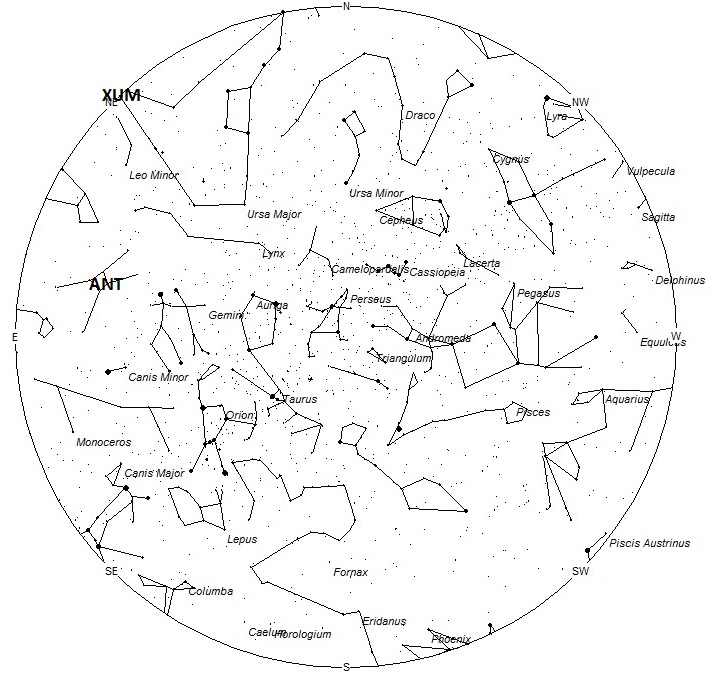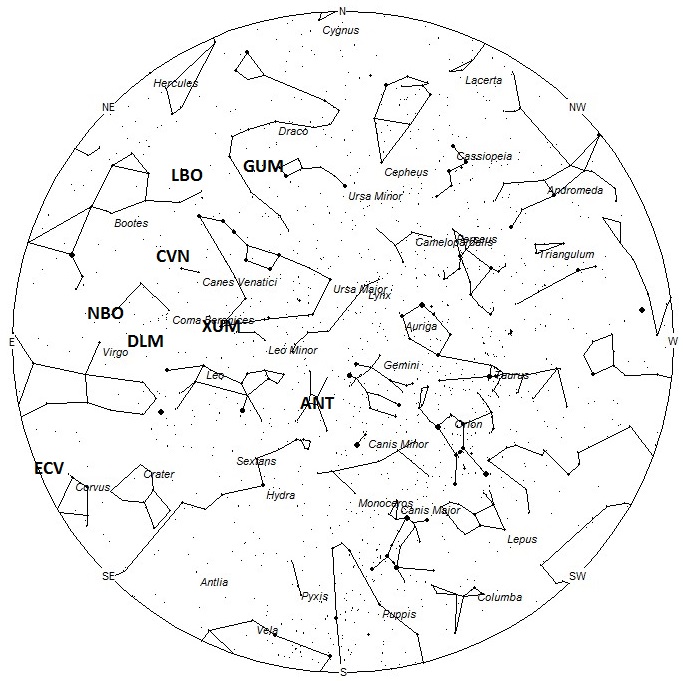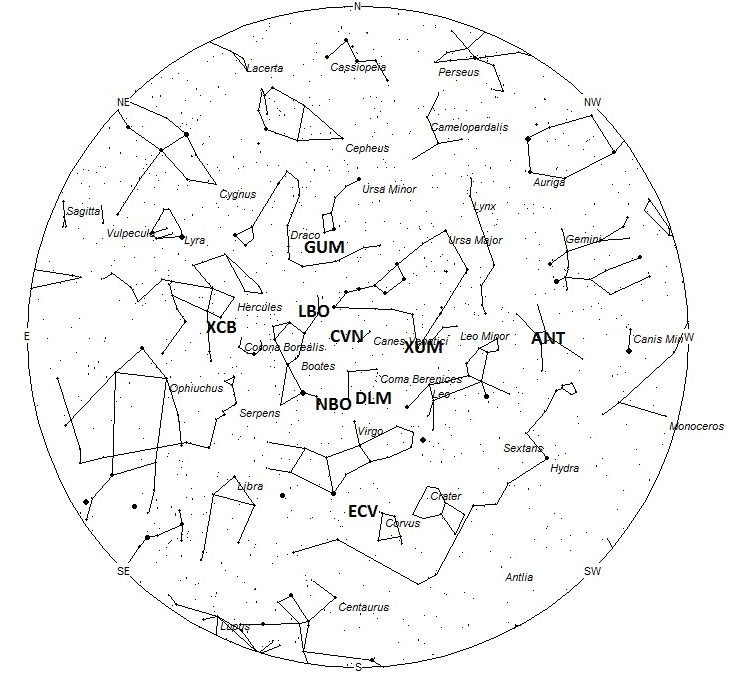
Space debris re-entries are often mistaken for meteors or fireballs.
During this period the moon reaches its first quarter phase on Saturday January 16th. On that date the moon will be located 90 degrees east of the sun and will set between midnight and 0100 local standard time (LST) as seen from most North American locations. As the week progresses the waxing gibbous moon will start to interfere with viewing during the morning hours. Toward the end of the week the moon will remain in the sky most of the night making meteor viewing difficult due to the bright lunar glare. The estimated total hourly meteor rates for evening observers this week is near 3 as seen from mid-northern latitudes (45N) and 3 as seen from tropical southern locations (25S). For morning observers the estimated total hourly rates should be near 11 as seen from mid-northern latitudes (45N) and 10 as seen from tropical southern locations (25S). The actual rates will also depend on factors such as personal light and motion perception, local weather conditions, alertness and experience in watching meteor activity. Evening rates during this period are reduced due to interfering moonlight. Note that the hourly rates listed below are estimates as viewed from dark sky sites away from urban light sources. Observers viewing from urban areas will see less activity as only the brightest meteors will be visible from such locations.
The radiant (the area of the sky where meteors appear to shoot from) positions and rates listed below are exact for Saturday night/Sunday morning January 16/17. These positions do not change greatly day to day so the listed coordinates may be used during this entire period. Most star atlases (available at science stores and planetariums) will provide maps with grid lines of the celestial coordinates so that you may find out exactly where these positions are located in the sky. A planisphere or computer planetarium program is also useful in showing the sky at any time of night on any date of the year. Activity from each radiant is best seen when it is positioned highest in the sky, either due north or south along the meridian, depending on your latitude. It must be remembered that meteor activity is rarely seen at the radiant position. Rather they shoot outwards from the radiant so it is best to center your field of view so that the radiant lies at the edge and not the center. Viewing there will allow you to easily trace the path of each meteor back to the radiant (if it is a shower member) or in another direction if it is a sporadic. Meteor activity is not seen from radiants that are located below the horizon. The positions below are listed in a west to east manner in order of right ascension (celestial longitude). The positions listed first are located further west therefore are accessible earlier in the night while those listed further down the list rise later in the night.
These sources of meteoric activity are expected to be active this week.
The center of the large Anthelion (ANT) radiant is currently located at 08:36 (129) +17. This position lies in central Cancer, just west of the 4th magnitude star Asellus Australis (Delta Cancri). Due to the large size of this radiant, Anthelion activity may also appear from western Leo, eastern Gemini, Canis Minor, northwestern Hydra as well as Cancer. This radiant is best placed near midnight local standard time (LST), when it lies on the meridian and is located highest in the sky. Rates at this time should be near 3 per hour as seen from the northern hemisphere and 2 per hour from south of the equator. With an entry velocity of 30 km/sec., the average Anthelion meteor would be of slow velocity.
The January Xi Ursae Majorids (XUM) were discovered by Japanese observers using data from SonotoCo. These meteors are active from January 16-20, with maximum activity occurring on the 18th. At maximum the radiant is located at 11:16 (169) +33. This position lies very close to the 3rd magnitude star known as Alula Borealis (Nu Ursae Majoris). These meteors would be best seen near 0400 LST when the radiant lies highest above the horizon. Hourly rates would most likely be low, less than 1 per hour no matter your location. These meteors encounter the atmosphere at 44 km/sec., which would produce meteors of average velocity.
The last of the December Leonis Minorids (DLM) should be seen this weekend from a radiant located at 12:24 (186) +18. This position lies in central Coma Berenices, 8 degrees northeast of the 2nd magnitude star Denebola (Beta Leonis). These meteors are best seen near 0400 LST when the radiant lies highest above the horizon. This shower peaked on December 21st so current rates would be less than 1 per hour no matter your location. At 63 km/sec. the December Leonis Minorids produce mostly swift meteors.
The Canum Venaticids (CVN) are a new shower discovered by Peter Brown and associates at the University of Western Ontario, using meteor orbits obtained by radar. This activity was verified by the IMO video network which has 271 possible candidates in its database. This shower is best seen from January 13-18, with maximum activity occurring on the 15th. At maximum the radiant is located at 14:04 (211) +37, which places it in eastern Canes Venatici, 5 degrees west of the 3rd magnitude star Seginus (Gamma Boötis). These meteors encounter the atmosphere at 56 km/sec., which would produce mostly medium-swift meteors. These meteors are best seen during the last few hours before dawn, when the radiant lies highest in a dark sky. This activity would be difficult to view from the southern hemisphere as the radiant lies low in the north at dawn. Expected hourly rates would be less than 1, even at maximum activity.
The X Corona Borealids (XCB) are another new shower discovered by Peter Brown and associates at the University of Western Ontario. This shower is best seen from January 11-18, with maximum activity occurring on the 15th. At maximum the radiant is located at 16:36 (249) +30, which actually places it within the borders of Hercules, 2 degrees southwest of the 3rd magnitude star Zeta Herculis. These meteors encounter the atmosphere at 49 km/sec., which would produce meteors of average velocity. These meteors are best seen during the last few hours before dawn, when the radiant lies highest in a dark sky. This activity would be difficult to view from the southern hemisphere as the radiant lies low in the north at dawn. Like the Canum Venaticids, this is a weak shower not expected to reach 1 per hour, even at maximum activity.
The Eta Corvids (ECV) were discovered by Sirko Molau while analyzing the data from the IMO network of video cameras. This shower is best seen from January 18-26, with maximum activity occurring on the 23rd. At maximum the radiant is located at 12:56 (194) -17. This position lies in eastern Corvus, 5 degrees east of the 3rd magnitude star known as Algorab (Delta Corvi). The IMO database has only 300 members of this shower so meteors would be fairly scarce with hourly rates less than 1, even at maximum activity. These meteors encounter the atmosphere at 69 km/sec., which would produce meteors of swift velocity. These meteors are best seen near 0300 LST, when the radiant lies highest above the horizon.
The Nu Boötids (NBO) were discovered by Yoshihiko Shigeno and Masa-yuki Yamamoto using analyses of double-station Image-Intensified video observations over Japan. These meteors are active from January 16-20 with maximum occurring on the 18th. The position of the radiant at maximum is 13:44 (206) +13. This position lies southwestern Boötes, 10 degrees southwest of the brilliant zero magnitude star known as Arcturus (Alpha Boötis). These meteors are best seen during the last few hours before dawn, when the radiant lies highest in a dark sky. Hourly rates would most likely be low, less than 1 per hour no matter your location. These meteors encounter the atmosphere at 67 km/sec., which would produce meteors of swift velocity.
The Lambda Boötids (LBO) were discovered by Peter Brown and his associates at the University of Western Ontario using the Canadian Meteor Orbit Radar. This source is only active for 2 nights with maximum occurring on January 17th. The radiant is located at 14:48 (222) +45. This position lies in northern Boötes, 4 degrees northwest of the 3rd magnitude star known as Nakkar (Beta Boötis). These meteors are best seen during the last few hours before dawn, when the radiant lies highest in a dark sky. Hourly rates would most likely be low, less than 1 per hour no matter your location. These meteors encounter the atmosphere at 41 km/sec., which would produce meteors of average velocity.
The Gamma Ursae Minorids (GUM) were also discovered by Peter Brown and his associates at the University of Western Ontario. These meteors are active from January 18-24, with maximum occurring on the 20th. At maximum the location of the radiant is 15:12 (228) +67, which places it southern Ursa Minor, 5 degrees south of the 3rd magnitude star known as Pherkad (Gamma Ursae Minoris). These meteors are best seen during the last few hours before dawn, when the radiant lies highest in a dark sky. Like most showers active during this period the hourly rates would most likely be low, less than 1 per hour no matter your location. These meteors encounter the atmosphere at 30 km/sec., which would produce meteors of medium-slow velocity.
As seen from the mid-northern hemisphere (45N) one would expect to see approximately 8 sporadic meteors per hour during the last hour before dawn as seen from rural observing sites. Evening rates would be near 2 per hour. As seen from the tropical southern latitudes (25S), morning rates would be near 8 per hour as seen from rural observing sites and 2 per hour during the evening hours. Locations between these two extremes would see activity between the listed figures.
| SHOWER | DATE OF MAXIMUM ACTIVITY | CELESTIAL POSITION | ENTRY VELOCITY | CULMINATION | HOURLY RATE | CLASS |
| RA (RA in Deg.) DEC | Km/Sec | Local Standard Time | North-South | |||
| Anthelions (ANT) | – | 08:36 (129) +17 | 30 | 00:00 | 3 – 2 | II |
| January Xi Ursae Majorids (XUM) | Jan 18 | 12:24 (186) +18 | 44 | 04:00 | <1 – <1 | IV |
| December Leo Minorids (DLM) | Dec 21 | 12:44 (191) +16 | 63 | 04:00 | <1 – <1 | IV |
| Eta Corvids (ECV) | Jan 23 | 12:56 (194) -17 | 69 | 04:00 | <1 – <1 | IV |
| Nu Bootids (NBO) | Jan 18 | 13:44 (206) +13 | 67 | 05:00 | <1 – <1 | IV |
| Canum Venaticids (CVN) | Jan 15 | 14:04 (211) +37 | 56 | 05:00 | <1 – <1 | IV |
| Lambda Bootids (LBO) | Jan 17 | 14:48 (222) +45 | 41 | 06:00 | <1 – <1 | IV |
| Gamma Ursae Minorids (GUM) | Jan 20 | 15:12 (228) +67 | 30 | 07:00 | <1 – <1 | IV |
| X Corona Borealids (XCB) | Jan 15 | 16:36 (249) +30 | 49 | 08:00 | <1 – <1 | IV |
 American Meteor Society
American Meteor Society



Hello, Robert…
I just want to thank you for the information on this site. I’ve been using FM forward-scatter to monitor meteor activity in my area (Marysville, Washington/48N, 122W). I’ve been running my system 24/7 since about a week prior to the Quadrantid shower, and I’ve been amazed at how many echoes I’ve been getting. (I’ve been generating 23-hour plots, as well as 6-day plots regularly).
Do you know where I could submit my results to determine if they correlate with “officially” predicted rates? Any information is appreciated.
Clear skies.
Jim Tegerdine
Hi there!
I just saw a very VERY bright meteor fall this evening of Jan. 19, 2016 in the south sky. I’m assuming this is due to the showers you have listed above. It was at around 11:40 Pacific time in the southern sky. The duration was about 3 seconds long! It went from around a 45 degree angle from the horizon directly downwards or southern to about w 10 degree angle. It was bright, almost neon green. The most peculiar attribute to this, though was that it seemed to “burn out” and then re-gain itself and fall and burn out again!
Pretty awesome! I’m so curious as to how these things can burn and re-light again. Fill me in if you can!
Emily
Emily and All,
There are 3 most likely reasons for a fireball to burn and re-light again.
(1) Most meteoroids that are not dust balls are not round but irregular in shape. Many are spinning and even if they fragment, the pieces often are brightest when their flat sides are directly it with the oncoming air stream and faintest when a “pointed” side spins into the direction of motion.
(2) If one object trails behind another, the shockwave of the front one spreads out laterally thus shielding the body behind it from the direct flow. If the back one moves laterally then it can move into the direct flow produced by the front one and flare up.
(3) If one object is made of a different composition from another one in the same vicinity, there will be a time difference between the maximum vaporization point of one object relative to the other. Thus they flare at two different times.
Many thanks to Dr. David Meisel, Executive Director of the AMS, for help with this question!
Robert Lunsford